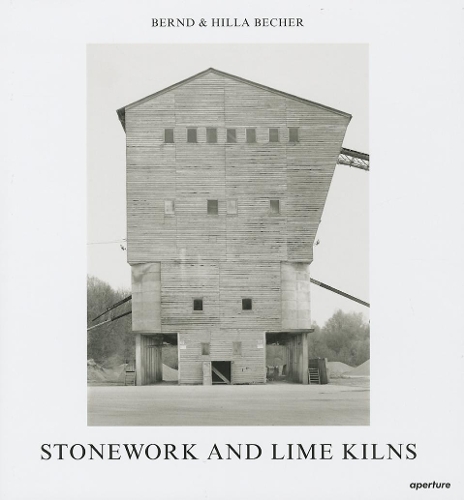
Stonework and Lime Kilns
(Hardback)
Publishing Details
Stonework and Lime Kilns
By (Author) Bernd Becher
By (author) Hilla Becher
Aperture
Aperture
6th January 2014
United States
Classifications
General
Non Fiction
779.962235
Physical Properties
Hardback
256
Width 270mm, Height 290mm
2110g
Description
Over the course of nearly five decades, Bernd and Hilla Becher documented almost every type of industrial architecturefrom water towers and steel mills to gas tanks and grain silosin Europe and the United States. Whether presenting single shots or their signature typological grids, the Bechers created a photographic testament to the industrial revolution that so emphatically shaped the nineteenth and twentieth centuries. At the same time, however, they also captured a much older manufacturing tradition: the quarrying and processing of stone. This volume, an essential addition to the Bechers' ouevre, is devoted to their photographs of rock-processing plants and lime kilns taken in Germany, France, The Netherlands, Belgium, Switzerland, Austria and Great Britain throughout the 1980s and 90s. Each structure is unique, its details dependent upon the region and the date of its construction, and the book features buildings whose essential function is ancient but which remain important today. Although a small number of these images have been included in previous monographs, this is the first publication to showcase a comprehensive collection of the Bechers' study of stonework and lime kilns.
Author Bio
Hilla Becher met Bernd Becher at the Kunskatademie Dsseldorf and first collaborated in 1959, while working as freelance photographers. Their lifelong commitment has been the systematic documentation of industrial buildings, including water towers and cooling towers, blast furnaces, coal mines and steel mines, gas tanks, and grain elevators. Starting in the late 60s, their work gained worldwide visibility via exhibition in such venues as the George Eastman House, Rochester, New York; Institute of Contemporary Arts, London: Documenta, Kassel, Germany; Bienal de So Paulo; Venice Bienale; and Centre Georges Pompidou, Paris. The Bechers were influential professors at the Dsseldorf Art Academy between 1976 and 1996, training a generation of photographers now known collectively as the Dsseldorf School. The Bechers work is represented in major collections worldwide, including the Museum of Modern Art, New York, and Tate Gallery, London, and they have received numerous awards, among the the Erasmus Prize and the Hasselblad Award. Over a dozen monographs of their work have been published, all focusing on the many faces of industrial architecture. Hilla Becher met Bernd Becher at the Kunskatademie Dsseldorf and first collaborated in 1959, while working as freelance photographers. Their lifelong commitment has been the systematic documentation of industrial buildings, including water towers and cooling towers, blast furnaces, coal mines and steel mines, gas tanks, and grain elevators. Starting in the late 60s, their work gained worldwide visibility via exhibition in such venues as the George Eastman House, Rochester, New York; Institute of Contemporary Arts, London: Documenta, Kassel, Germany; Bienal de So Paulo; Venice Bienale; and Centre Georges Pompidou, Paris. The Bechers were influential professors at the Dsseldorf Art Academy between 1976 and 1996, training a generation of photographers now known collectively as the Dsseldorf School. The Bechers work is represented in major collections worldwide, including the Museum of Modern Art, New York, and Tate Gallery, London, and they have received numerous awards, among the the Erasmus Prize and the Hasselblad Award. Over a dozen monographs of their work have been published, all focusing on the many faces of industrial architecture. Hilla Becher met Bernd Becher at the Kunskatademie Dsseldorf and first collaborated in 1959, while working as freelance photographers. Their lifelong commitment has been the systematic documentation of industrial buildings, including water towers and cooling towers, blast furnaces, coal mines and steel mines, gas tanks, and grain elevators. Starting in the late 60s, their work gained worldwide visibility via exhibition in such venues as the George Eastman House, Rochester, New York; Institute of Contemporary Arts, London: Documenta, Kassel, Germany; Bienal de So Paulo; Venice Bienale; and Centre Georges Pompidou, Paris. The Bechers were influential professors at the Dsseldorf Art Academy between 1976 and 1996, training a generation of photographers now known collectively as the Dsseldorf School. The Bechers work is represented in major collections worldwide, including the Museum of Modern Art, New York, and Tate Gallery, London, and they have received numerous awards, among the the Erasmus Prize and the Hasselblad Award. Over a dozen monographs of their work have been published, all focusing on the many faces of industrial architecture. Hilla Becher met Bernd Becher at the Kunskatademie Dsseldorf and first collaborated in 1959, while working as freelance photographers. Their lifelong commitment has been the systematic documentation of industrial buildings, including water towers and cooling towers, blast furnaces, coal mines and steel mines, gas tanks, and grain elevators. Starting in the late 60s, their work gained worldwide visibility via exhibition in such venues as the George Eastman House, Rochester, New York; Institute of Contemporary Arts, London: Documenta, Kassel, Germany; Bienal de So Paulo; Venice Bienale; and Centre Georges Pompidou, Paris. The Bechers were influential professors at the Dsseldorf Art Academy between 1976 and 1996, training a generation of photographers now known collectively as the Dsseldorf School. The Bechers work is represented in major collections worldwide, including the Museum of Modern Art, New York, and Tate Gallery, London, and they have received numerous awards, among the the Erasmus Prize and the Hasselblad Award. Over a dozen monographs of their work have been published, all focusing on the many faces of industrial architecture.
